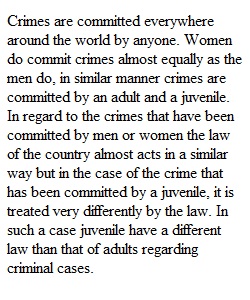


Q Case Study #1 Please conduct a comparative analysis of two criminal justice policies that address the same problem and critically assess the similarities and differences. Some of the areas you might consider addressing, depending on your topic, include: • Definitions of the problem • How the problem is measured • History of the problem (previous research & policies; previous successes or failures) • Description of the policy, policy analysis methods, & policy recommendations • Theory behind the policy • Quality of supporting research (including contradictory findings) • Evaluation research & outcome research regarding the policies • Conditions favorable or unfavorable for policy adoption & roles of stakeholders, public opinion, experts, politicians • Possible unintended consequences & conflicts • Feasibility • Critique • Consistency with legal, moral, & ethical principles • Intensity of change (major change, minor change, continuing as before) • Fit with other related policies Case Study #1 Comments Please find a few comments to assist you with case study #1. First, please make sure you chose a criminal justice related topic. Second, you do not need to address all of the areas listed. You need to determine which areas are important for your comparative analysis and then focus specifically on those items. Third, papers usually range from 4-6 pages but the important thing is content. Also, an appendix might be very appropriate to put in material you want us to see but does not need to be in the main text. Fourth, please check out the domestic violence example posted on our home page. Finally, please feel free to email me your ideas for this case study if you have any questions and I would be glad to comment. Please find additional details on some of the areas: • Definitions of the problem-make sure we know exactly how the problem is defined. • How the problem is measured-please discuss how the problem is measured-that is, is there reliable and valid data regarding the topic? • History of the problem (previous research & policies; previous successes or failures)-there may be research that demonstrates the effectiveness or ineffectiveness of policies. You might use some of those studies in your comparisons. • Description of the policy, policy analysis methods, & policy recommendations-this will probably be integrated with the other areas I have listed. • Theory behind the policy-I believe there will always be a theory behind every policy but it may not be apparent at first glance. You will have to look at the assumptions of the policy to get to the theory unless the theory is stated clearly. Often it is not. • Quality of supporting research (including contradictory findings) • Evaluation research & outcome research regarding the policies • Conditions favorable or unfavorable for policy adoption & roles of stakeholders, public opinion, experts, and politicians-consider the politics of your policy. For example, I believe I have some excellent policy ideas to reduce crime but understand there will be very little public support. Politicians and policymakers face this dilemma on a daily basis. • Possible unintended consequences & conflicts-Are there some things that could go wrong with the specific policies that don’t seem to be apparent at first glance. For example, is the new prescription drug registration a good idea? Many think so, but are there some possible negative effects that could occur? • Feasibility-is it a policy that can actually be implemented? • Critique-your critique of each policy could easily go along with some of the other areas mentioned. • Consistency with legal, moral, & ethical principles-may be a lot more difficult to assess than one would think. • Intensity of change (major change, minor change, continuing as before)-like it or not, it is easier to make a small change than a large one. Just think of New Year’s resolutions! • Fit with other related policies-we can and maybe should use other policies that have proven to be successful.
View Related Questions